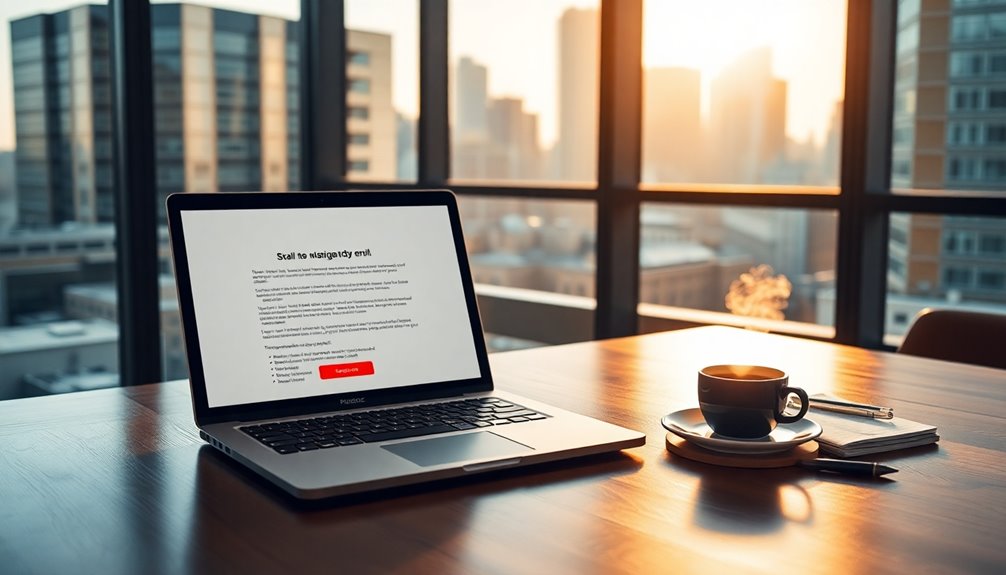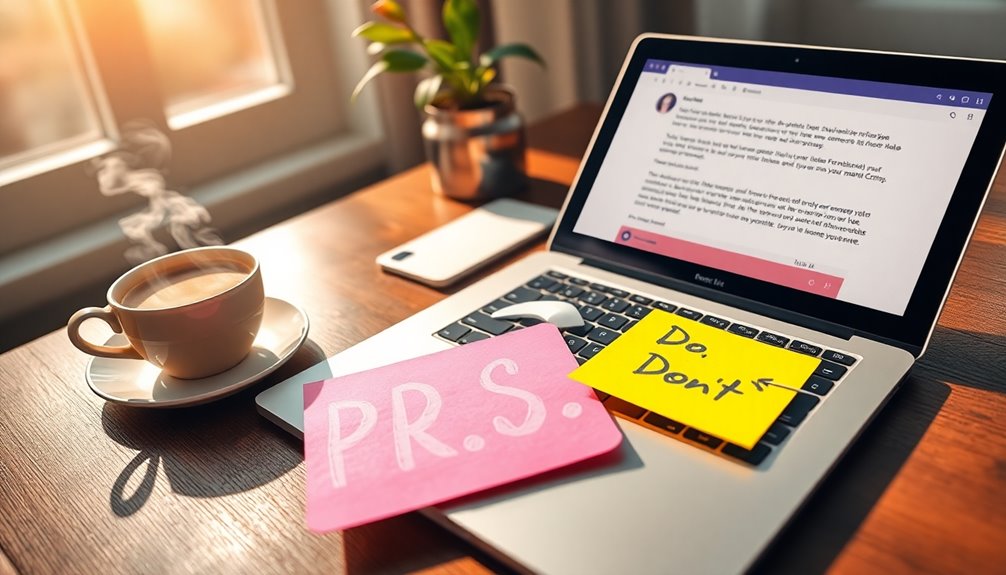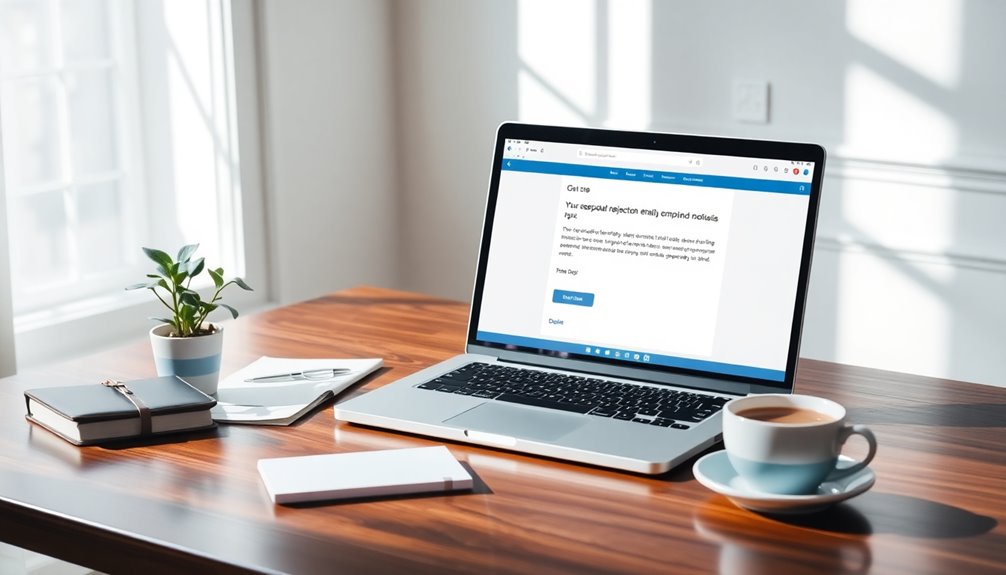To drive engagement with your P.S., keep it concise and impactful. Start by restating your key message or call to action—this reinforces what you want your reader to do. Use urgent language, like "Limited time offer!" to create a sense of FOMO. Personalize your P.S. by addressing recipients by name, making it feel more relevant. Also, consider A/B testing different messages to see which ones resonate better with your audience. Doing this can significantly boost your email's effectiveness and conversion rates. Stick around, and you'll discover more tips for crafting compelling emails that captivate your audience!
Key Takeaways
- Start with a strong call to action in the P.S. to direct readers on their next steps effectively.
- Create urgency with phrases like "Limited time offer!" to prompt immediate engagement.
- Personalize the P.S. by addressing the recipient by name to enhance connection and relevance.
- Keep the P.S. concise, limiting it to one or two impactful sentences for clarity.
- A/B test different P.S. messages to identify which resonates best with your audience and improves engagement.
Introduction

Using the P.S. effectively in your emails can make a significant difference in how your message is received. The P.S. section, often overlooked, is actually a powerful engagement tool. Research shows that over 90% of readers check the P.S. first, which means you can capture their attention right when they finish reading your main message.
When you craft an effective P.S., you can boost your conversion rates by restating a call to action or highlighting a limited-time offer. This encourages recipients to act immediately, enhancing the overall impact of your marketing efforts.
Personalizing your P.S. with the recipient's name or specific details creates a connection that feels tailored and relevant, increasing the likelihood of engagement.
Additionally, consider A/B testing different P.S. messages to discover which styles resonate best with your audience. This way, you refine your approach and maximize both engagement and effectiveness.
Boosts Reader Engagement Instantly

The P.S. section in your emails boosts reader engagement instantly by drawing attention right after the main content. This simple addition can significantly increase engagement rates, capturing your readers' focus when they might otherwise disengage.
By reinforcing key messages, a well-crafted P.S. enhances the emotional appeal of your email, making it especially effective in fundraising efforts.
Incorporating urgency into your P.S. can prompt immediate action. For instance, mentioning a limited-time offer creates a sense of FOMO (Fear of Missing Out) that drives quick responses.
Personalization is another game-changer; addressing recipients by name or tailoring your message based on segmentation fosters a feeling of individual attention, which boosts reader engagement.
Don't forget the power of A/B testing! Experimenting with different P.S. statements can reveal which variations resonate best with your audience, leading to higher open and click-through rates.
By strategically using the P.S. section, you can turn a mundane email into a compelling message that encourages your audience to act without hesitation.
Compelling Call to Action

When crafting a P.S. section, including a compelling call to action (CTA) is crucial for driving engagement. A well-placed P.S. CTA can significantly boost your click-through rates—studies show it can increase them by up to 30%. Visualization techniques can be particularly effective in enhancing the impact of your message and encouraging your audience to take action. Incorporating strong communication skills can also help in clearly conveying your message and motivating your audience. Additionally, leveraging the concept of continuous learning can further refine your messaging approach over time.
To achieve this, ensure your message is clear and concise, using action-oriented language like "Click here to save 20%!" This directs your reader's next steps effectively. Furthermore, utilizing segmentation of audience can help tailor your P.S. message to specific recipient groups for even greater relevance.
Incorporating a sense of urgency can further enhance response rates. Phrases like "Limited time offer!" create FOMO (Fear of Missing Out), prompting immediate action.
Additionally, personalizing your P.S. CTA by addressing the recipient by name or referencing their past interactions can make your message resonate more, leading to increased engagement. Tailoring your approach can reflect your understanding of the recipient's needs and values.
Consider using A/B testing to identify which P.S. CTAs yield the highest engagement. By experimenting with different phrasing or offers, you can optimize your emails for better performance. Furthermore, data-driven insights from AI in Digital Marketing allow you to refine your approach based on audience behavior and preferences.
Step-by-Step Guide to Writing P.S

Crafting an effective P.S. in your email can be a game-changer for engagement. Start by summarizing the key takeaway or offer from your email in the P.S. This reinforces its importance and grabs the reader's attention. Crafting an effective P.S. in your email can be a game-changer for engagement. Start by summarizing the key takeaway or offer from your email in the P.S. This reinforces its importance and grabs the reader's attention. Additionally, use the space to create a sense of urgency or curiosity, encouraging them to take immediate action. For instance, if you’re promoting an email nurture sequence template, highlight how it can simplify their workflow or boost conversions. A compelling P.S. can be the extra push your readers need to click through and engage with your content.
When adding a P.S., create urgency by including phrases like "limited-time offer" or "act now" to encourage them to take action immediately.
Next, personalize the P.S. by addressing the recipient by name or referencing previous interactions. This connection enhances engagement and makes your message feel more tailored.
Keep your tone concise and impactful; limit the P.S. to one or two sentences to maintain clarity without overwhelming the reader.
Finally, don't shy away from experimentation. Use A/B testing with different P.S. messages to see which variations increase engagement the most. Additionally, segmenting your audience based on behavior and preferences can help tailor your P.S. for even greater impact.
Dos and Don'ts for P.S. Usage

Using P.S. effectively can significantly enhance your email's impact, but there are key dos and don'ts to keep in mind.
First, do keep it concise. Aim for one to two impactful sentences in your P.S. to maintain clarity and avoid overwhelming your readers. A well-placed P.S. can serve as a powerful tool when it's brief and to the point.
Next, do create urgency. Use time-sensitive language or limited-time offers to encourage immediate action from your audience. This way, your readers will feel compelled to respond quickly.
Additionally, do personalize your message. Tailor the P.S. to resonate with your audience's interests or needs, enhancing engagement and connection.
On the flip side, don't overload with information. Avoid cramming too many details into the P.S.; it should enhance the email, not clutter it.
Moreover, don't use irrelevant content. Ensure that the P.S. relates directly to the main email message to maintain coherence and relevance.
Examples of P.S. Strategies

In today's fast-paced digital world, employing effective P.S. strategies can make a significant difference in how your emails are received.
Consider using urgency to prompt immediate action. For example, "P.S. Act now to receive 20% off until midnight!" taps into FOMO and captures attention. Extended separations can lead to emotional disconnection, which can be mirrored in the lack of response to your email.
Adding a personal touch is also key; you might say, "P.S. Can't wait to hear your thoughts on our recent project; your feedback means a lot!" This builds rapport and encourages engagement. Communication often deteriorates during time apart, so reaching out can help mend those gaps.
Don't shy away from highlighting additional offers, like "P.S. Sign up today and receive a free e-book!" This enhances perceived value and drives conversions.
Reinforcing your call to action is crucial too. You can remind readers with, "P.S. Don't forget to click here to join our exclusive webinar!" This ensures your message stands out, especially for skimmers.
Additionally, creating a sense of emotional connection can enhance engagement, as seen in how strong communication skills can improve relationships. Trust issues may arise due to lack of interaction, making it essential to foster those connections through your emails.
Pro Tips for Writing Effective Emails

When you want your emails to stand out, focusing on key elements can make all the difference. Start with a clear and compelling subject line, as 47% of recipients open emails based solely on that.
Next, personalize your emails by addressing recipients by name and tailoring content to their interests. This simple step can boost engagement rates by up to 26%.
Keep your email body concise and focused. Aim for 50-125 words to ensure key points are easy to identify. Incorporate a strong call to action (CTA) early on to guide your readers, and don't forget to reinforce that CTA in the P.S. This tactic can significantly boost click-through rates and increase conversions by up to 371%.
To continually enhance your email strategy, utilize A/B testing. This method allows you to determine what resonates best with your audience, making your emails more effective over time.
Always strive to provide extra value that feels real in your company. By following these pro tips, you'll not only improve your email engagement but also build stronger connections with your audience.
Final Thoughts

Crafting effective emails goes beyond just the main content; the P.S. can be a powerful tool to engage your audience further. By placing key messages in the P.S., you can boost engagement since over 90% of readers check it first.
To maximize its impact, incorporate urgency. Limited-time offers can prompt immediate action, driving higher conversion rates. Additionally, eliminating distractions during email composition helps maintain focus and clarity, resulting in better-crafted messages. Using advanced segmentation techniques can also ensure your P.S. reaches the right audience, increasing its effectiveness. Furthermore, overcoming public speaking anxiety can be beneficial in crafting messages that resonate confidently with your readers. Implementing cookie management practices can also enhance user experience and ensure your messages are well-received.
Don't forget to personalize your P.S. Addressing recipients by name fosters a stronger connection, enhancing trust and loyalty among your audience.
Keeping your P.S. concise is crucial; clarity ensures your message resonates without overwhelming readers.
Regularly test different P.S. strategies and monitor your engagement metrics. This ongoing refinement helps you tailor your content, making it more effective over time. Additionally, consider using email marketing strategies to enhance your outreach and engagement efforts.
Frequently Asked Questions
How Do You Say PS in a Professional Email?
In a professional email, you simply write "P.S." before adding your additional thoughts.
It's a way to highlight something important without cluttering your main message.
Make sure it's relevant and aligns with the overall tone of your email.
You can use it to remind your reader about deadlines, special offers, or key points.
Just keep it concise, ideally one to two sentences, so it remains impactful and clear.
How Do You Drive Email Engagement?
To drive email engagement, start by personalizing your messages. Use the recipient's name and tailor content to their interests.
Craft compelling subject lines that spark curiosity or urgency, as they're crucial for open rates. Incorporate clear calls to action to guide readers toward taking the next step.
A/B test various elements to see what resonates best, and utilize segmentation to target specific groups for even greater impact.
These strategies will boost your engagement significantly.
How Do You Write an Engaging Email?
To write an engaging email, start with a catchy subject line that sparks curiosity.
Personalize your message by using the recipient's name and referencing their interests.
Keep your content concise, using short paragraphs and bullet points for easy reading.
Include a strong call to action, guiding them on the next step.
How Do You Write an Engaging Follow up Email?
To write an engaging follow-up email, start with a friendly greeting and remind the recipient of your last conversation.
Use a clear subject line that grabs attention.
Keep your message concise and personalize it by mentioning specific details from your previous interaction.
Don't forget to include a P.S. that highlights a key point or call to action, creating a sense of urgency that encourages a quick response.
Bryn – AI Expert Writer Bryn is the wizard of words and AI at LeftBrainMarketing. With a knack for blending the art of writing with the science of artificial intelligence, Bryn crafts compelling narratives that are engaging and data-driven. Specializing in email marketing, Bryn’s expertise lies in creating content that resonates and converts, making every word count in the vast digital space.









![Personalization Basics: Beyond "Hello [Name]" in Your Emails 27 advanced email personalization techniques](https://leftbrainmarketing.net/wp-content/uploads/2025/11/advanced_email_personalization_techniques_7bop8-260x140.jpg)
